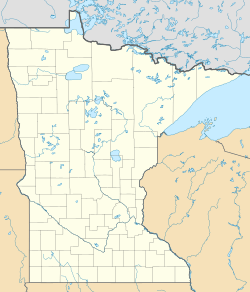Daniel Dayton House facts for kids
The Daniel Dayton House, also known as Ravine House, is a very old building in Harmony Township, Minnesota. It was built in 1857. This house was a special inn where people traveling by stagecoach could stay overnight. It was a stop on an important mail and travel route called the Dubuque–St. Paul Stage Road. This road went through Iowa and Minnesota.
The Daniel Dayton House is important because it is one of the few stagecoach inns left in Minnesota. It also shows the history of early settlers in Harmony Township. Because of its history and unique stone style, the house was added to the National Register of Historic Places in 1977.
Contents
Early Days of Harmony Township
The first settlers came to what is now Harmony, Minnesota, in 1853. They needed a way to connect with other towns. They wanted to trade goods and send messages.
A year later, in 1854, the Dubuque–St. Paul Trail was created. Harmony Township became a stop on this long route. The trail was about 272-mile (438 km) long. It was used for mail and stagecoaches.
Building the Ravine House
A new immigrant named Daniel Dayton saw a chance to start a business. In 1855, he built a small log building. It was in a village called Big Spring, about 3.5 miles (5.6 km) from Harmony. At first, he offered food and drinks to tired travelers. Soon, he also offered places to sleep overnight.
In 1857, Daniel Dayton added a bigger part to his building. This new part was made of limestone. It was two and a half stories tall. The walls were very thick, about 20 inches (51 cm) wide. The windows had a special design with double-hung sashes. They also had limestone sills and decorated lintels. The roof was a gabled shape with two brick chimneys.
Life at Ravine House
Daniel Dayton painted "Ravine House" on a sign and hung it over the front door. This was to welcome visitors. The first and second floors had beds for guests. There were also beds that could slide out from under others. Even the small attic had extra sleeping spots.
Ravine House was more than just a place to sleep. It was also a place where horses could be kept and cared for. It had a small store, a post office, and was Daniel Dayton's family home.
The End of the Stagecoach Era
Daniel Dayton and his sons, Aaron and Zara, ran Ravine House. They kept it open for stagecoach travelers until 1866. After this time, fewer people used the Dubuque–St. Paul Trail. This was because railroads started to become popular.
Even though a railroad line didn't reach Harmony until 1879, other lines opened nearby. These new train lines took away most of the travelers from the stagecoach route. The busy trail became quiet.
While running Ravine House, Daniel Dayton also served in the Minnesota Legislature. He was also the chairman, clerk, and postmaster for Harmony Township.
Saving a Piece of History
Daniel Dayton passed away in 1895. After that, Ravine House was used as a private home for many years. In 1952, it was left empty. It was then used to store food and hay for farm animals.
The building started to fall apart. But a group of people who cared about history decided to save it. In the 1970s, they worked to fix it up. They replaced the windows and the roof. They also fixed the wood floors and made the foundation strong again. They tried their best to make the house look like it did when it was first built. In 1977, Ravine House was officially added to the National Register of Historic Places.




